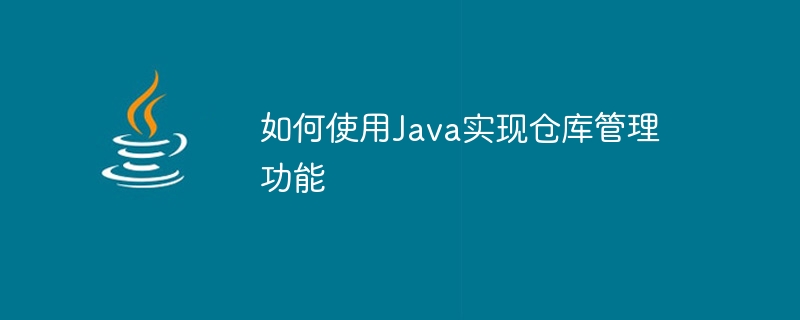Home >Java >javaTutorial >How to use Java to implement warehouse management functions
How to use Java to implement warehouse management functions
- 王林Original
- 2023-09-25 10:52:571858browse

How to use Java to implement warehouse management functions
- Introduction
Warehouse management is an indispensable part of enterprise operations. It involves the handling of goods. Important links such as entry and exit, storage and inventory management. The warehouse management system can be easily implemented using the Java language. This article will introduce how to use Java to implement the warehouse management function and give specific code examples. - Functional requirements analysis
Before introducing the specific code implementation, we need to first determine the basic functions required by the warehouse management system, which generally include the following aspects: - Entry and entry of goods View: including the name, model, quantity, purchase date and other information of the goods;
- Outbound goods: According to the inventory situation, select the goods to be outbound and fill in the outbound quantity;
- Inventory Management: Automatically calculate the inventory quantity of goods and update them in time;
- Goods query: Query goods information based on keywords;
- Data persistence: Save data to files for next time reads.
- Steps to use Java to implement warehouse management functions
The following are the basic steps to use Java to implement warehouse management functions:
3.1 Create Java classes and related attributes
First, We need to create a "Goods" class to represent goods, which contains attributes such as the name, model, quantity, and purchase date of the goods.
public class Goods {
private String name;
private String model;
private int quantity;
private Date purchaseDate;
// 构造方法、getters和setters省略...
}3.2 Implement the function of entering and viewing goods
Considering that the warehouse may store a large amount of goods, we use a List collection to save the goods objects and provide corresponding methods to implement the function of entering and viewing the goods. .
import java.util.ArrayList;
import java.util.List;
public class Warehouse {
private List<Goods> goodsList;
public Warehouse() {
goodsList = new ArrayList<>();
}
public void addGoods(Goods goods) {
goodsList.add(goods);
}
public List<Goods> getGoodsList() {
return goodsList;
}
}3.3 Implement the outbound function of goods
The outbound function requires selecting the goods to be outbound based on the inventory status of the goods and filling in the outbound quantity. We can retrieve goods based on their name or model and update the inventory quantity.
public class Warehouse {
// ...
public void outGoods(String name, int quantity) {
for (Goods goods : goodsList) {
if (goods.getName().equals(name) && goods.getQuantity() >= quantity) {
goods.setQuantity(goods.getQuantity() - quantity);
return;
}
}
System.out.println("库存不足,无法出库。");
}
}3.4 Implementing the query function of goods
In order to facilitate querying cargo information based on keywords, we can provide a query method in the warehouse class and return a list of goods that meet the conditions.
public class Warehouse {
// ...
public List<Goods> searchGoods(String keyword) {
List<Goods> result = new ArrayList<>();
for (Goods goods : goodsList) {
if (goods.getName().contains(keyword) || goods.getModel().contains(keyword)) {
result.add(goods);
}
}
return result;
}
}3.5 Data persistence
In order to achieve persistent storage of data, we can use Java's file operations to save data to files and read the data when needed.
import java.io.*;
import java.util.List;
public class DataIO {
public void saveData(List<Goods> goodsList, String fileName) {
try (PrintWriter writer = new PrintWriter(new FileWriter(fileName))) {
for (Goods goods : goodsList) {
writer.println(goods.getName() + "," + goods.getModel() + "," + goods.getQuantity() + "," + goods.getPurchaseDate());
}
} catch (IOException e) {
e.printStackTrace();
}
}
public List<Goods> loadData(String fileName) {
List<Goods> goodsList = new ArrayList<>();
try (BufferedReader reader = new BufferedReader(new FileReader(fileName))) {
String line;
while ((line = reader.readLine()) != null) {
String[] parts = line.split(",");
Goods goods = new Goods();
goods.setName(parts[0]);
goods.setModel(parts[1]);
goods.setQuantity(Integer.parseInt(parts[2]));
goods.setPurchaseDate(new SimpleDateFormat("yyyy-MM-dd").parse(parts[3]));
goodsList.add(goods);
}
} catch (IOException | ParseException e) {
e.printStackTrace();
}
return goodsList;
}
}- Summary
This article introduces how to use Java to implement warehouse management functions, including the entry, viewing, outbound, query and data persistence of goods. Through the above steps and code examples, You can further customize and extend it according to your needs to achieve more specific functions. Of course, due to space limitations, this article only gives basic code examples. In actual projects, more details and special situations need to be taken into consideration. I hope readers can continue to explore and improve in practice.
The above is the detailed content of How to use Java to implement warehouse management functions. For more information, please follow other related articles on the PHP Chinese website!
Related articles
See more- How to implement the function of converting text into pictures using PHP
- Implementation of component paging function in Vue2.5 and Element UI
- How to get the current time in javascript
- Using Java to develop batch warehousing and cargo traceability functions of the warehouse management system
- How to use PHP and Vue to develop warehouse temperature and humidity monitoring functions for warehouse management

